The Guidance and Control of Urban Planning for Reuse of Industrial Heritage: A Study of Nanjing
Abstract
:1. Introduction
- In the process of urban development, the preservation of industrial heritage sites is influenced by many aspects, such as humanities, material, society, and politics, and these aspects involve many stakeholders: citizens, governments, developers and other groups. In the complex process of pursuing interests, some industrial heritage sites give way to urban development, while many old factories are idle due to the difficulty of reaching an agreement about the reuse purposes of industrial sites [16].
- The original road system in industrial land usually has a special service function, which can only meet the needs of industrial production and transportation but cannot directly undertake new urban functions. When traffic and streamlining in these areas cannot effectively connect with the urban traffic system, these historical industrial areas may lose their significance and potential for reuse [17].
- With urban development and expansion, the historic industrial areas in many cities have become the center of the city, and their land value has rapidly increased. However, due to the scattered layout and large area occupancy, the existence of old industrial land reduces the function agglomeration effect of urban central areas to some extent.
- Sometimes, large old factories are not conducive to shaping the overall landscape of the city.
- With the adjustment of the industrial layout and upgrading of the industrial structure, a large number of workers have to be laid off or are forced to retire. The huge amount of laid-off workers in old industrial areas is not conductive to the stability and harmony of urban society. At the same time, most of the residents in industrial areas usually belong to the low-income class in the city. The improvement of the overall economic vitality of the city will face difficulty due to their limited consumption level [18].
- Most industrial enterprises will cause a certain degree of pollution to the urban eco-environment, and they also have a certain negative impact on the lives of urban residents. In addition, although the factories located in some industrial sites have stopped production, the damage caused to the urban eco-environment in the past has not been fully recovered [19].
2. Materials and Methods
2.1. Study Area
2.1.1. Spatial Scope of This Study
- First, Nanjing is the most typical city to study industrial heritage in China.
- Second, Nanjing has entered a development stage focusing on renewal and redevelopment, and one of its subjects is the large amount of industrial land where modern industrial buildings are located.
2.1.2. Temporal Scale of This Study
2.1.3. Definition of Research Object
“Industrial heritage consists of the remains of industrial culture which are of historical, technological, social, architectural, or scientific value. These remains consist of buildings and machinery, workshops, mills and factories, mines and sites for processing and refining, warehouses and stores, places where energy is generated, transmitted and used, transport and all its infrastructure, as well as places used for social activities related to industry such as housing, religious worship or education […]. The historical period of principal interest extends forward from the beginning of the Industrial Revolution in the second half of the eighteenth century up to and including the present day, while also examining its earlier preindustrial and protoindustrial roots. In addition, it draws on the study of work and working techniques encompassed by the history of technology.” [79].
“The industrial heritage contains both the tangible and the intangible industrial remains of historical, sociological, architectural, technological or aesthetic value, including factories, workshops, mills, warehouses, shops and other industrial structures; mines, processing and smelting sites, energy production sites, transmission and usage sites, transportation facilities, social activities sites with industrial production, industrial equipment, production technology, data records, enterprise culture […]. Since the First Opium War, there have been various industrial remains left as the legacy of all phases of modern industrial construction in China, which constitute the principal part of China’s industrial heritage, witness and record the change and development of modern Chinese society.” [81].
2.2. Data
2.3. Data Analysis
2.3.1. Statistical Analysis
2.3.2. Spatiotemporal Pattern Analysis
2.3.3. Identification of Influencing Factors and Explanations of Some Terms
- Urban growth boundary
- The urban growth boundary is a multi-objective planning tool to control urban space, aiming to maximize ecological, economic and social benefits, whilst trying to guide urban development in suitable areas; avoid risk areas; and protect ecologically sensitive areas, such as forest land, water area and farmland. At the same time, it can optimize the use of infrastructure and public service facilities by combining the concept of compact growth.
- The “boundary” of urban growth is not a fixed boundary. The permanent growth boundary and dynamic growth boundary can be defined according to the needs of urban development. While urban areas are growing rapidly in China, urban growth not only needs to delimit the “rigid” red line of the permanent undeveloped protected area, but it also needs to deal with the elastic “dynamic” boundary for unpredictable development in the suburban district.
- Traffic accessibility
- Population distribution
- Industrial renovation investment
- Natural resource change
- Eco-environmental policies
- Operation state
- Function choice of industrial heritage reuse
- Urban central area
- Metropolitan area
3. Results
3.1. Influence of Different Factors on the State of Labor-Intensive Industrial Heritage Sites
3.2. Influence of Different Factors on the State of Capital-Intensive Industrial Heritage Sites
3.3. Influence of Different Factors on the State of Technology-Intensive Industrial Heritage Sites
3.4. Influence of Different Factors on the State of Resource-Intensive Industrial Heritage Sites
3.5. Reuse Characteristics of Nanjing Industrial Heritage Sites
- The reuse purposes of most historical industrial sites were determined according to the characteristics of the geographical environment;
- The purpose of reuse varied, and most industrial heritage sites were reused in a varied manner, paying attention to the sustainability of building functions (Figure 33).
- Figure 33 summarizes the excellent works of industrial heritage reuse in Nanjing. These cases pay more attention to the sustainability of a building’s function, but they lack attention to landscapes remaining around the site, such as industrial communities spontaneously built around these sites.
- In the process of reusing industrial heritage sites, the authenticity and integrity of many industrial architectural heritage sites are lacking, for example, Nanjing Line Equipment Factory and Baijingyu Ophthalmic Pharmaceutical Factory (Figure 34).
4. Discussion
5. Conclusions
Author Contributions
Funding
Data Availability Statement
Acknowledgments
Conflicts of Interest
References
- He, C.; Wei, Y.D.; Xie, X. Globalization, Institutional Change, and Industrial Location: Economic Transition and Industrial Concentration in China. Reg. Stud. 2009, 42, 923–945. [Google Scholar] [CrossRef]
- Coe, N.M.; Hess, M.; Yeung, H.W.; Dicken, P.; Henderson, J. “Globalizing” Regional Development. Trans. Inst. Br. Geogr. 2004, 29, 468–484. [Google Scholar] [CrossRef]
- Yeung, H.W. Regional Development and the Competitive Dynamics of Global Production Networks: An East Asian Perspective. Reg. Stud. 2009, 43, 325–351. [Google Scholar] [CrossRef]
- Wei, Y.H.D.; Liao, F.H.F. The Embeddedness of Transnational Corporations in Chinese Cities: Strategic Coupling in Global Production Networks? Habitat Int. 2013, 40, 82–90. [Google Scholar] [CrossRef]
- Practically Unify Thoughts into the Spirit of Chinese 18th CPC Central Committee Third Plenary Session. Available online: http://politics.people.com.cn/n/2014/0101/c1024-23994509.html (accessed on 20 May 2022).
- Kang, J.; Zhang, Z.; Fu, Y. China’s Economic Transformation and Growth. Manag. World 2007, 1, 7–17. [Google Scholar] [CrossRef]
- Walker, R. Industry Builds the City: The Suburbanization of Manufacturing in San Francisco Bay Area, 1850–1940. J. Hist. Geogr. 2001, 27, 36–57. [Google Scholar] [CrossRef] [Green Version]
- Walker, R.; Lewis, R.D. Beyond the Crabgrass Frontier: Industry and the Spread of North American Cities, 1850–1950. J. Hist. Geogr. 2001, 27, 3–19. [Google Scholar] [CrossRef] [Green Version]
- Lewis, R.D. A City Transformed: Manufacturing Districts and Suburban Growth in Montreal, 1850–1929. J. Hist. Geogr. 2001, 27, 20–35. [Google Scholar] [CrossRef]
- Muller, E.D. Industrial Suburbs and Growth of Metropolitan Pittsburgh, 1870–1920. J. Hist. Geogr. 2001, 27, 58–73. [Google Scholar] [CrossRef]
- Gilli, F. Sprawl or Reagglomeration? The Dynamics of Employment Deconcentration and Industrial Transformation in Greater Paris. Urban. Stud. 2009, 46, 1385–1420. [Google Scholar] [CrossRef] [Green Version]
- Gao, B.; Liu, W.; Michael, D. State Land Policy, Land Markets and Geographies of Manufacturing: The Case of Beijing, China. Land Use Policy 2014, 36, 1–12. [Google Scholar] [CrossRef]
- Li, X. Old Town Renovation in Nanjing During the Past 30 Years—Based on the Case Study of Urban Renewel Process. Master’s Thesis, Southeast University, Nanjing, China, 2016. [Google Scholar]
- Luo, Z. Architectural Anthology of Luo Zhewen; Foreign Language Press: Beijing, China, 1999; p. 334. [Google Scholar]
- Chen, L. Nanjing Modern Industrial Architecture Study. Ph.D. Thesis, Southeast University, Nanjing, China, 2018. [Google Scholar]
- Xu, Z.; Yang, C. Re-recognition of Historical Architectural Value. Archit. J. 2011, S2, 103–106. [Google Scholar]
- Zhu, H. Study on the Integration of Industrial Heritage’s Conservation and Reuse into Urban Space—Take Nanjing as the Case. Master’s Thesis, Nanjing University, Nanjing, China, 2012. [Google Scholar]
- Li, Y. Research on the Protection and Development of Industrial Heritage under the Background of Urban Renewal. Master’s Thesis, Northwest University, Nanjing, China, 2010. [Google Scholar]
- Wang, G. Present Situation and Approaches of Industrial Heritage Preservation in Nanjing. Urban Rural Dev. 2018, 22, 28. [Google Scholar]
- Osman, R.; Frantál, B.; Klusáček, P.; Kunc, J.; Martinat, S. Factors affecting brownfield regeneration in post-socialist space: The case of the Czech Republic. Land Use Policy 2015, 48, 309–316. [Google Scholar] [CrossRef]
- Amekudzi, A.; Fomunung, I. Integrating Brownfields Redevelopment with Transportation Planning. J. Urban Plan. Dev. 2004, 130, 204–212. [Google Scholar] [CrossRef]
- Brooks, C.N. A Model for Redeveloping Complex, Highly Contaminated Sites the Industry-plex Site in Woburn, Massachusetts. WIT Trans. Ecol. Environ. 2006, 94, 229–238. [Google Scholar]
- Thomas, M.R. A GIS Based Decision Support System for Brownfield Redevelopment. Landsc. Urban Plan. 2002, 58, 7–23. [Google Scholar] [CrossRef]
- Rowan, G.T.; Fridgen, C. Brownfields and environmental justice: The threats and challenges of contamination. Environ. Pract. 2003, 5, 58–61. [Google Scholar] [CrossRef]
- Mathey, J.; RöBler, S.; Banse, J.; Lehmann, I.; Bräuer, A. Brownfields as an Element of Green Infrastructure for Implementing Ecosystem Services into Urban Areas. J. Urban Plan. Dev. 2015, 141, 1–13. [Google Scholar] [CrossRef]
- Sousa, C.A.D. Measuring the Public Costs and Benefits of Brownfield Versus Greenfield Development in the Greater Toronto Area. Environ. Plan. B Plan. Des. 2002, 29, 251–280. [Google Scholar] [CrossRef]
- Gilderbloom, J.I.; Meares, W.L.; Riggs, W. How Brownfield Sites Kill Places and People: An Examination of Neighborhood Housing Values, Foreclosures, and Lifespan. J. Urban. Int. Res. Placemak. Urban Sustain. 2014, 9, 1–18. [Google Scholar] [CrossRef]
- Kuchinski, A.M.; Lyon, M.; Gibson, R. The Need to Consider Social and Cultural Factors When Reporting Successful Non-hospital Transmission Strategies for COVID-19. Intern. Emerg. Med. 2021, 16, 1023–1025. [Google Scholar] [CrossRef]
- Buchanan, R.A. Industrial Archaeology in Britain; Penguin Books Ltd.: New York, NY, USA, 1972. [Google Scholar]
- Alfrey, J.; Putnam, T. The Industrial Heritage: Managing Resources and Uses; Routledge: London, UK, 2003. [Google Scholar] [CrossRef]
- Truscott, M.C. Burra Charter: The Australia ICOMOS Charter for Places of Cultural Significance (1999). In Encyclopedia of Global Archaeology; Smith, C., Ed.; Springer: New York, NY, USA, 2014; pp. 1078–1082. [Google Scholar]
- Dastgerdi, A.S.; Luca, G.D. Specifying the Significance of Historic Sites in Heritage Planning. Conserv. Sci. Cult. Herit. 2018, 18, 29–39. [Google Scholar] [CrossRef]
- Liu, B. A Review of Industrial Architecture Heritage Research in China. New Archit. 2012, 2, 4–9. [Google Scholar]
- Que, W. Industrial Heritage in China—It’s Past, Present and the Future. In Proceedings of the TICCIH Seminar on Training and Education within the Field of Industrial Heritage, Stockholm, Sweden, 8–11 June 2008. [Google Scholar]
- Shan, J. Focusing on a New Cultural Heritage—The Protection of Industrial Heritage. China Cult. Herit. 2006, 4, 10–47. [Google Scholar] [CrossRef]
- Wang, J.; Jiang, N. Conservation and Adaptive-reuse of Historical Industrial Building in China in the Post-industrial Era. Front. Archit. Civ. Eng. China 2007, 1, 474–480. [Google Scholar] [CrossRef]
- Que, W. China’s Traditional Industrial Heritage in the View of World Heritage. J. Econ. Geogr. 2008, 130, 1040–1044. [Google Scholar] [CrossRef]
- Lu, N.; Liu, M.; Wang, R. Reproducing the discourse on industrial heritage in China: Reflections on the evolution of values, policies and practices. Int. J. Herit. Stud. 2020, 26, 498–518. [Google Scholar] [CrossRef]
- Kidney, W.C. Working Places: The Adaptive Use of Industrial Buildings; Ober Park Associates: Pittsburgh, PA, USA, 1976. [Google Scholar]
- Ball, R. Developers, Regeneration and Sustainability Issues in the Reuse of Vacant Industrial Buildings. Build. Res. Inf. 1999, 3, 140–148. [Google Scholar] [CrossRef]
- Rodopoulou, T.C. Control Shift: European Industrial Heritage Reuse in Review. Ph.D. Thesis, Delft University of Technology, Delft, The Netherlands, 2020. [Google Scholar] [CrossRef]
- Shipley, R.; Utz, S.; Parsons, M. Does Adaptive Reuse Pay? A Study of the Business of Building Renovation in Ontario, Canada. Int. J. Herit. Stud. 2006, 6, 505–520. [Google Scholar] [CrossRef]
- Langenbach, R. A Future from the Past: The Case for Conservation and Reuse of Old Buildings in Industrial Communities; US Government Printing Office: Washington, DC, USA, 1977.
- Tiesdell, S. Tensions Between Revitalization and Conservation: Nottingham’s Lace Market. Cities 1995, 4, 231–241. [Google Scholar] [CrossRef]
- Kenneth, P. Architecture Reborn: The Conversion and Reconstruction of Old Buildings; Laurence King: London, UK, 1999. [Google Scholar]
- Latham, D. Creative Reuse of Buildings; Donhead: Shaftesbury, UK, 2000; Available online: https://scholar.google.com/scholar_lookup?title=Creative+Reuse+of+Buildings&author=Latham,+D.&publication_year=2000 (accessed on 20 May 2022).
- Stratton, M. Industrial Buildings: Conservation and Regeneration; Taylor & Francis: London, UK, 2000. [Google Scholar] [CrossRef]
- Hassler, U.; Kohler, N. Das Verschwinden Der Bauten Des Indutriezeitalters: Lebenszyklen Industrieller Baubestande Und Methoden Transdisziplinarer Forschung; Ernst Wasmuth Verlag: Tübingen, Germany, 2004. [Google Scholar]
- Xie, P.F. Developing Industrial Heritage Tourism: A Case Study of the Proposed Jeep Museum in Toledo, Ohio. Tour. Manag. 2006, 6, 1321–1330. [Google Scholar] [CrossRef]
- Eley, P.; Worthington, J. Industrial Rehabilitation: The Use of Redundant Buildings for Small Enterprises; The Architectural Press: London, UK, 1984. [Google Scholar]
- Hospers, G. Industrial Heritage Tourism and Regional Restructuring in the European Union. Eur. Plan. Stud. 2002, 3, 397–404. [Google Scholar] [CrossRef]
- Chen, F.; Wang, C. Industrial Building Remains and Transitional Housing. New Archit. 2003, 2, 4–6. [Google Scholar]
- Yang, K.; Zhao, C. Preliminary Study on the Space Regeneration Method of Industrial Buildings. New Archit. 2012, 2, 10–16. [Google Scholar]
- Guo, C.; Jiao, S.; Zhang, W. Discussion on the Space Transformation Method of Industrial Heritage. Shanghai Urban Plan. Rev. 2015, 5, 54–58. [Google Scholar]
- Wei, Z. Preservation, Regeneration and Reuse of Industrial Buildings. Urban. Archit. 2005, 2, 15–16. [Google Scholar]
- Zhang, S. Preservation and Adaptive Reuse of Shanghai Industrial Heritage. Archit. J. 2006, 8, 16–20. [Google Scholar]
- Liang, Y.; Li, Z. Research on “Symbiosis” Strategy of Industrial Heritage Preservation and Reuse. Urban Plan. Int. 2010, 4, 67–71. [Google Scholar]
- Jiang, N. Evaluation Techniques and Methods of Industrial Heritage Value Based on Adaptive Reuse. New Archit. 2016, 3, 4–9. [Google Scholar]
- Ruan, Y.; Zhang, S. Industrial Heritage Preservation Promotes the Development of Urban Cultural Industry: Difficulties and Opportunities Faced by Shanghai Cultural Industry Zone. Urban Plan. Forum 2004, 4, 53–57, 96. [Google Scholar]
- Chen, Z. From Singular Building Protection to the Preservation and Regeneration of Old Industrial Areas: A Brief Analysis of the Preservation and Reuse Mode of Italian Historical Industrial Buildings and Lots. Planners 2007, 7, 5–7. [Google Scholar]
- Dong, Y.; Hou, B. Preservation of Railway Buildings and Regional Regeneration: Study of Two Historical Railway Stations in Manchester, England. Urban. Archit. 2011, 8, 25–28. [Google Scholar]
- Thomas, B.; Thomas, S.; Powell, L. The Development of Key Characteristics of Welsh Island Cultural Identity and Sustainable Tourism in Wales. Sci. Cult. 2017, 3, 23–39. [Google Scholar] [CrossRef]
- Obeidat, B.; Miqdady, H. Preserving the Traditional Watermills in Wadi Orjan Jordan Using an Analytic Hierarchy Process. Sci. Cult. 2021, 7, 21–30. [Google Scholar] [CrossRef]
- Ye, Y.; Liu, X. Analysis on the Advantages and Restrictive Factors of the Transformation and Utilization of Historical Industrial Buildings. Ind. Archit. 2005, 6, 35–38. [Google Scholar]
- Feng, L.; Tang, Z. Renewal of Allocated Industrial Land from the Perspective of Property Rights System: A Case Study of Hongkou District, Shanghai. Urban Plan. Forum 2013, 5, 23–29. [Google Scholar]
- Zhang, P.; Wu, X. Analysis of Institutional Evolution and Protection and Regeneration of Industrial Architectural Heritage: Taking Shanghai as an Example. City Plan. Rev. 2016, 9, 75–83. [Google Scholar]
- Assassi, A.; Mebarki, A. Spatial Configuration Analysis via Digital Tools of the Archeological Roman Town Timgad, Algeria. Mediterr. Archaeol. Archaeom. 2021, 21, 71–84. [Google Scholar] [CrossRef]
- Boukhalfa, B.B. Space Syntax Theory Identifies the Ethical Reversal Trend of the Overwhelmed Mādina of Al-Djaza’Ir Urban Morphology. Mediterr. Archaeol. Archaeom. 2022, 22, 155–182. [Google Scholar] [CrossRef]
- Mahmoud, H.S.A. Multiscientific Approach for the Characterization and Assessment of the Degradation State of the Historical Al-Shafi’I Mosque Walls (Jeddah, Kingdom of Saudi Arabia). Sci. Cult. 2021, 7, 1–19. [Google Scholar] [CrossRef]
- Moreno, M.; Ortiz, P.; Ortiz, R. Vulnerability Study of Earth Walls in Urban Fortifications Using Cause-Effect Matrixes and GIS: The Case of Seville, Carmona and Estepa Defensive Fences. Mediterr. Archaeol. Archaeom. 2019, 19, 119–138. [Google Scholar] [CrossRef]
- Alghazawi, R.; Waheeb, M.; Kraishan, D. Cultural Heritage Management Adaptation in the Arab World: Review & Perspectives. Mediterr. Archaeol. Archaeom. 2015, 15, 11–21. [Google Scholar]
- Wang, Y.; Chun, Q.; Xiong, X.; Zhu, T. Conservation and adaptive reuse of modern military industrial heritage: A case study on the former site of Jinling Arsenal in Nanjing, China. J. Asian Archit. Build. Eng. 2021, 21, 1193–1210. [Google Scholar] [CrossRef]
- Tsui, C. State Capacity in City Planning: The Reconstruction of Nanjing, 1927–1937. Cross-Curr. East Asian Hist. Cult. Rev. 2011, 1, 1–43. [Google Scholar] [CrossRef]
- Yuan, F.; Gao, J.; Wu, J. Nanjing-an ancient city rising in transitional China. Cities 2016, 50, 82–92. [Google Scholar] [CrossRef]
- Yao, Y. Essential Geography Landscapes and Ecological Culture in Nanjing. Acta Geogr. Sin. 2009, 64, 677–686. [Google Scholar]
- Ye, J.; Yang, X.; Xiong, L.; Yan, Y.; Wang, T. Point Pattern Analysis of Urban Buildings in Nanjing old Town. J. Geo-Inf. Sci. 2015, 17, 1404–1411. [Google Scholar] [CrossRef]
- Nanjing Industrial Heritage Protection Planning Has Been Completed, and a Number of “Old Factories” Have Been Listed in the Protection List. Available online: https://www.sohu.com/a/167944206_168681 (accessed on 20 May 2022).
- Ünal, S. Ceramic Production from Neolithic Doğanhisar Pottery Culture: Intangible Heritage of Technology Transfer from Past to Present. Sci. Cult. 2021, 7, 77–91. [Google Scholar] [CrossRef]
- TICCIH. Nizhny Tagil Charter for the Industrial Heritage; TICCIH: Nizhny Tagil, Russia, 2003; p. 2. Available online: https://ticcih.org/about/charter/ (accessed on 20 May 2022).
- Liu, B. An Overview of the Evolved Protection of Industrial Building Heritage. Archit. J. 2012, 521, 12–17. [Google Scholar]
- State Administration of Cultural Heritage. Wuxi Proposal—Focus on Industrial Heritage Protection in the Period of Rapid Economic Development. Archit. Des. 2006, 8, 195–196. [Google Scholar]
- Nanjing City Platform for Common GeoSpatial Information Services. Available online: http://www.njmap.gov.cn (accessed on 20 May 2022).
- Nanjing Municipal Bureau of Statistics. Nanjing Statistical Yearbook; China Statistics Press: Beijing, China, 1991–2021. [Google Scholar]
- Nanjing Local Records Compilation Committee Office. Nanjing Yearbook; Nanjing Yearbook Editorial Department: Nanjing, China, 1991–2021. [Google Scholar]
- Xu, Y.; Xu, L. Nanjing Industrial Heritage; Nanjing Press: Nanjing, China, 2012. [Google Scholar]
- Lu, W.; Chen, W. Manufacturing Industry Enterprises Location Choice and the Urban Spatial Restructuring in Nanjing. Acta Geogr. Sin. 2009, 64, 142–152. [Google Scholar]
- Evolution of Nanjing Rail Transit Network. Available online: https://www.sohu.com/a/317155816_688176 (accessed on 20 May 2022).
- Evaluating Nanjing Urban Master Planning Implementation and Related Reflections. Available online: http://www.mur.cn/journals/2011/4/MUR-2011-4-e27a3d4e8014504e8a58e9dbbe1bd56a.html (accessed on 20 May 2022).
- Nanjing Urban Master Plan (2011–2020). Available online: http://ghj.nanjing.gov.cn/ghbz/ztgh/201705/t20170509_874089.html (accessed on 20 May 2022).
- Wang, Y.; Gu, C.; Li, X. Research Progress of Urban Growth Boundary at Home and Abroad. Urban Plan. Int. 2014, 29, 2. [Google Scholar]
- Hansen, W.G. How Accessibility Shapes Land Use. J. Am. Inst. Plan. 1959, 25, 73–76. [Google Scholar] [CrossRef]
- Lin, P. Overview of Accessibility Research Methods. West. Resour. 2022, 1, 194. [Google Scholar] [CrossRef]
- Office of Nanjing Local Chronicles Compilation Committee. Nanjing Architectural Chronicles; Local Chronicles Publishing House: Nanjing, China, 1996. [Google Scholar]
- Li, H. Open Mining Fold in Zhijing. Complete Works of Li Hongzhang; Anhui Educational Press: Hefei, China, 2008; Volume 9, p. 339. [Google Scholar]
- Sun, Y. The International Development of China; G.P.Putnam’s Sons: New York, NY, USA, 1922. [Google Scholar]
- Compilation Committee of this Factory Records. China Cem. Fact. Rec. 1985.
- Chen, B. Records of Jiangnan Cement Factory; Jiangnan Cement Factory Editorial Board: Nanjing, China, 1995. [Google Scholar]
- Protection Plan of Nanjing Historical and Cultural Area (2010–2020). Available online: http://www.nanjing.gov.cn/xxgkn/zt/ghxxgk_70036/sew/kjgh_70051/202111/t20211119_3201774.html (accessed on 20 May 2022).
- Zhu, G. Industrial Development, Intensive Land Use and Urban Expansion. Resour. Environ. Yangtze Basin 2020, 29, 1474. [Google Scholar] [CrossRef]
- Zhou, M.; Yuan, M.; Huang, Y.; Lin, K. Effects of Institutions on Spatial Patterns of Manufacturing Industries and Policy Implications in Metropolitan Areas: A Case Study of Wuhan, China. Land 2021, 10, 710. [Google Scholar] [CrossRef]
- Lee, S.; Shin, S.; Chung, J. Influence of Construction of Innovative City on the Population and Industrial Structure of Jinju City. J. Resid. Environ. Inst. Korea 2019, 17, 173–186. [Google Scholar] [CrossRef]
- Zhu, L.; Guo, Q.; Xiao, L.; Yang, L. Spatial Structure Characteristics of Urban System and Its Influencing Factors in Fujian Province. Areal Res. Dev. 2019, 38, 42–47. [Google Scholar] [CrossRef]
- Ma, W.; Liu, H. Why is China’s Urbanization Uncoordinated? From the Perspective of Local Government Behavior. J. Cent. Univ. Financ. Econ. 2018, 8, 113–120. [Google Scholar]
- The Heritage of Mankind. Available online: https://www.zollverein.de/zollverein-unesco-world-heritage-site/ (accessed on 20 May 2022).
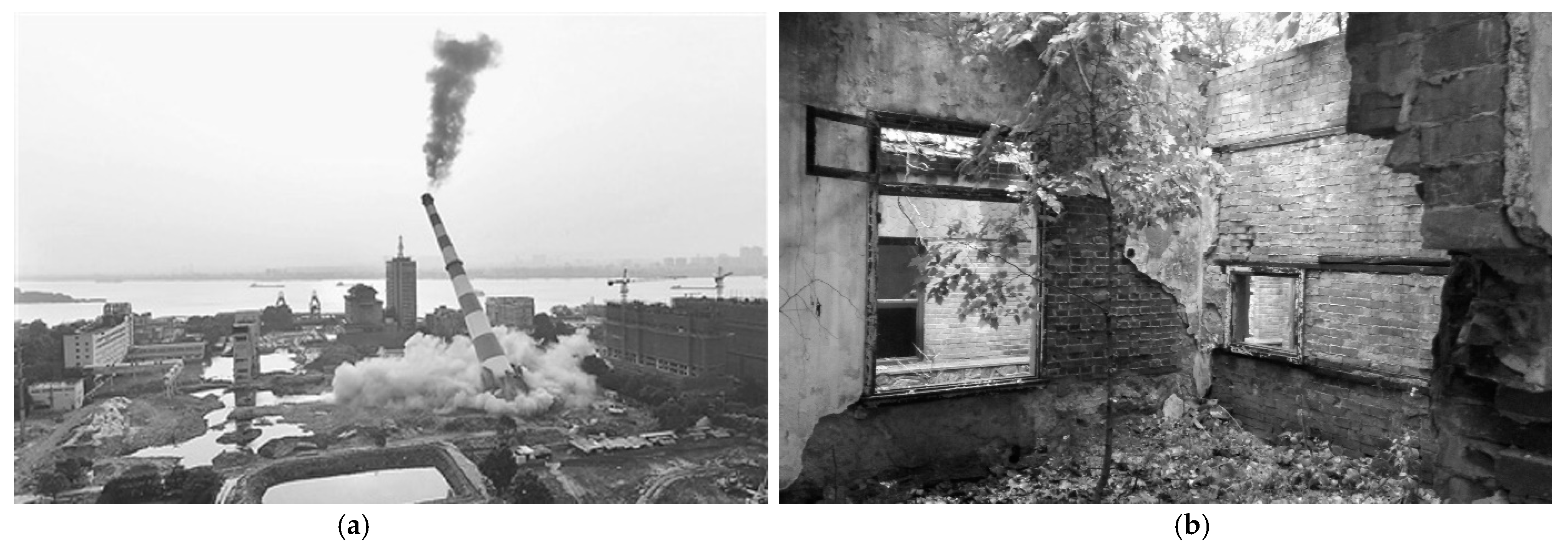
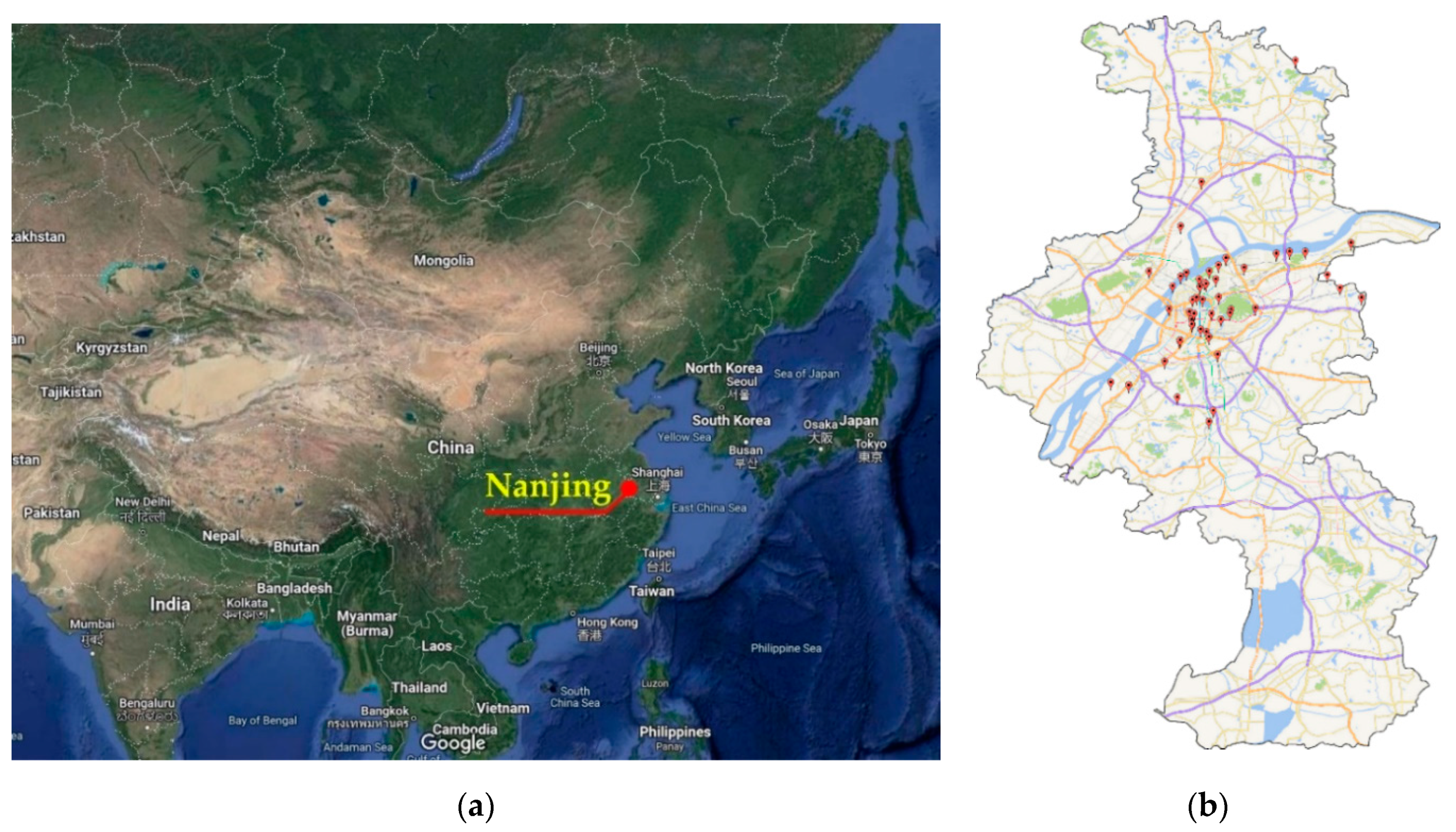
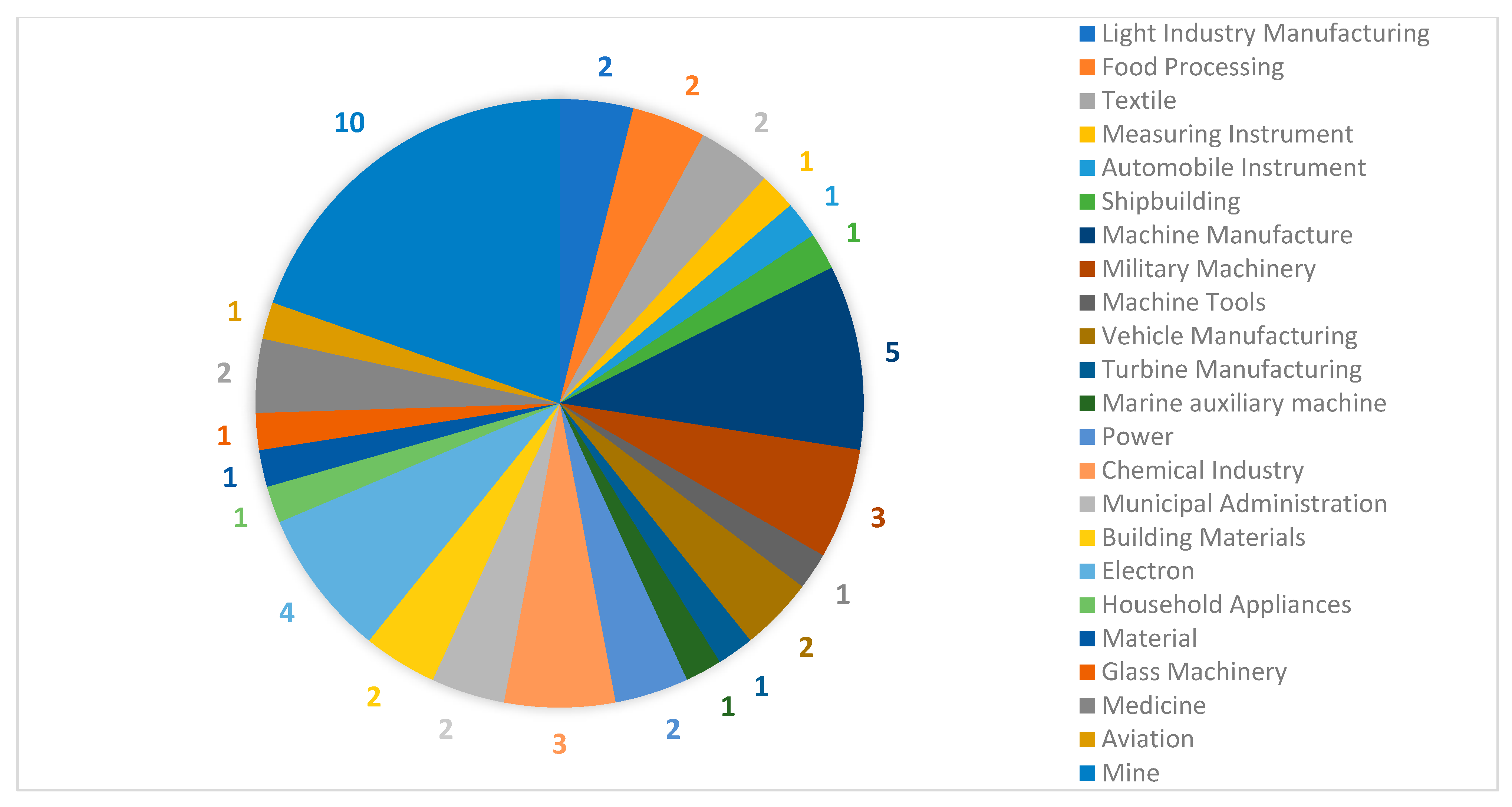
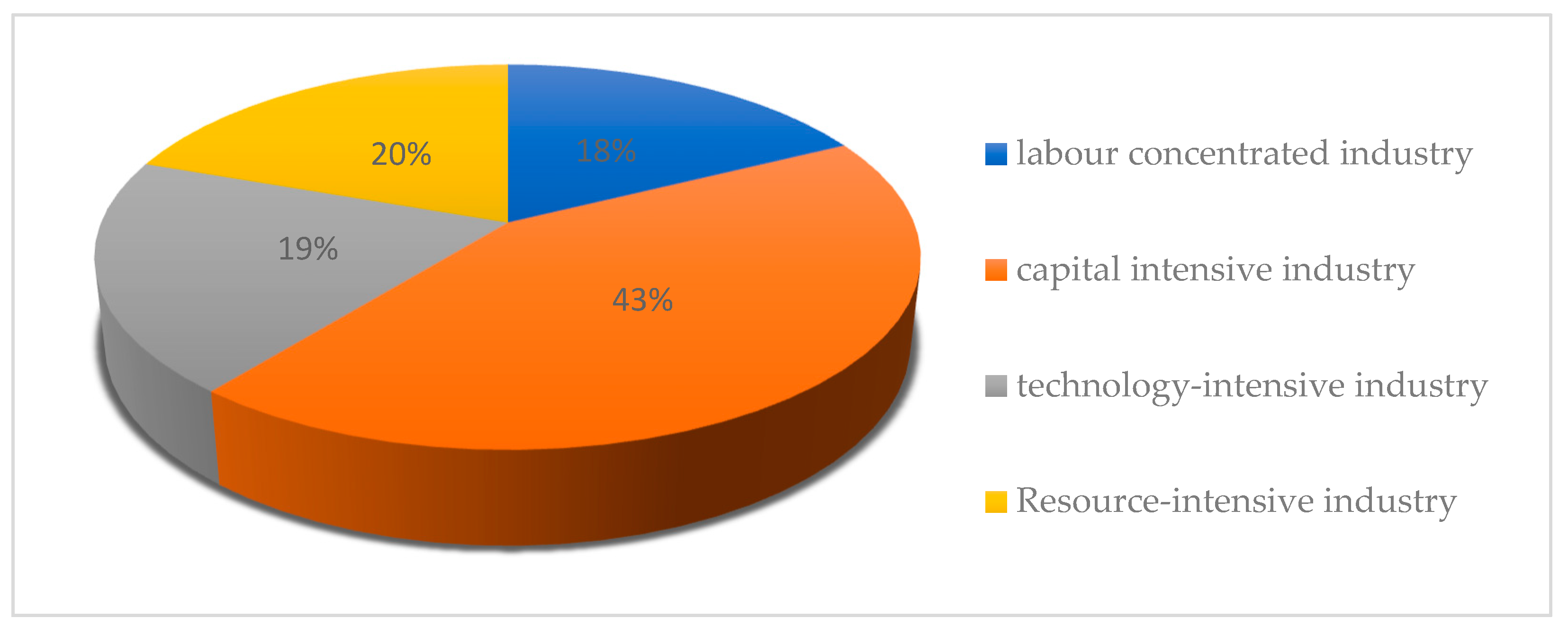
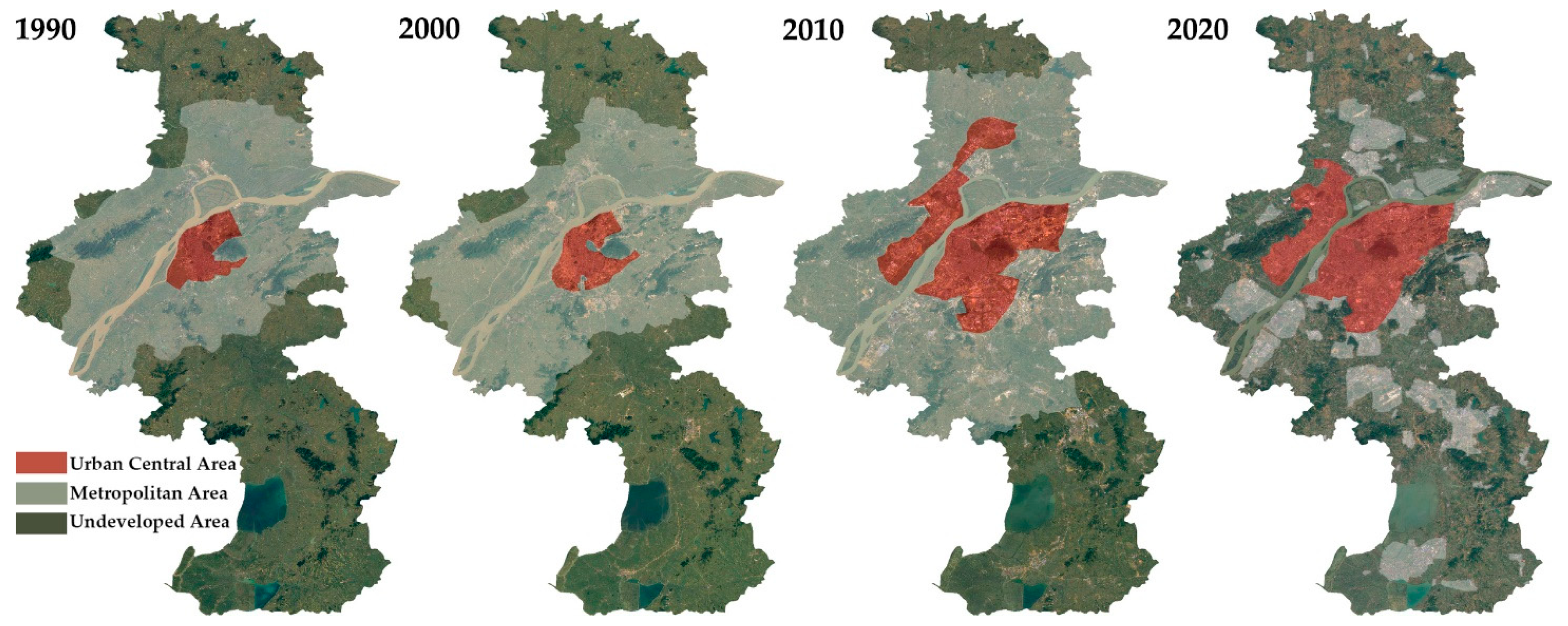
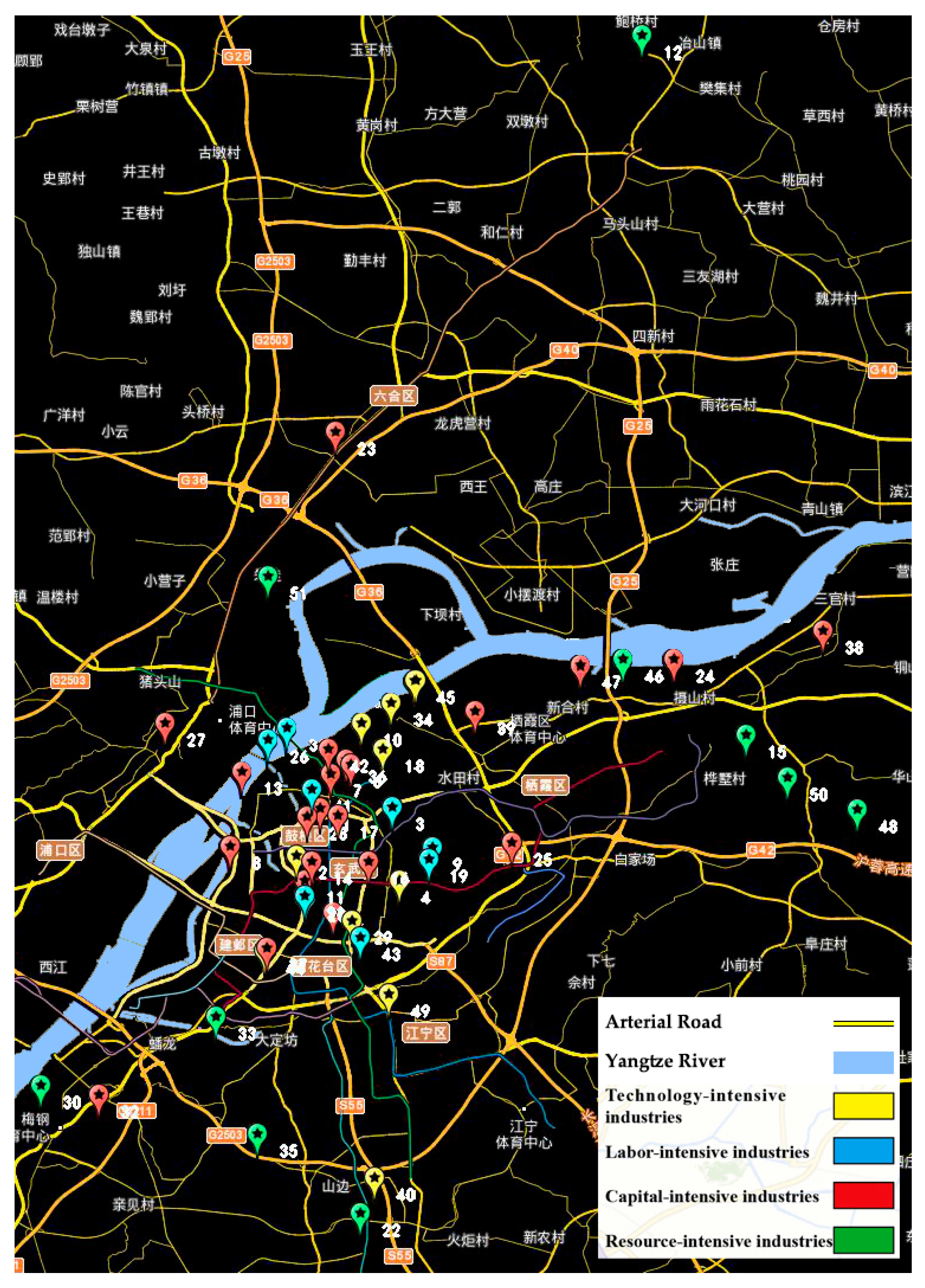



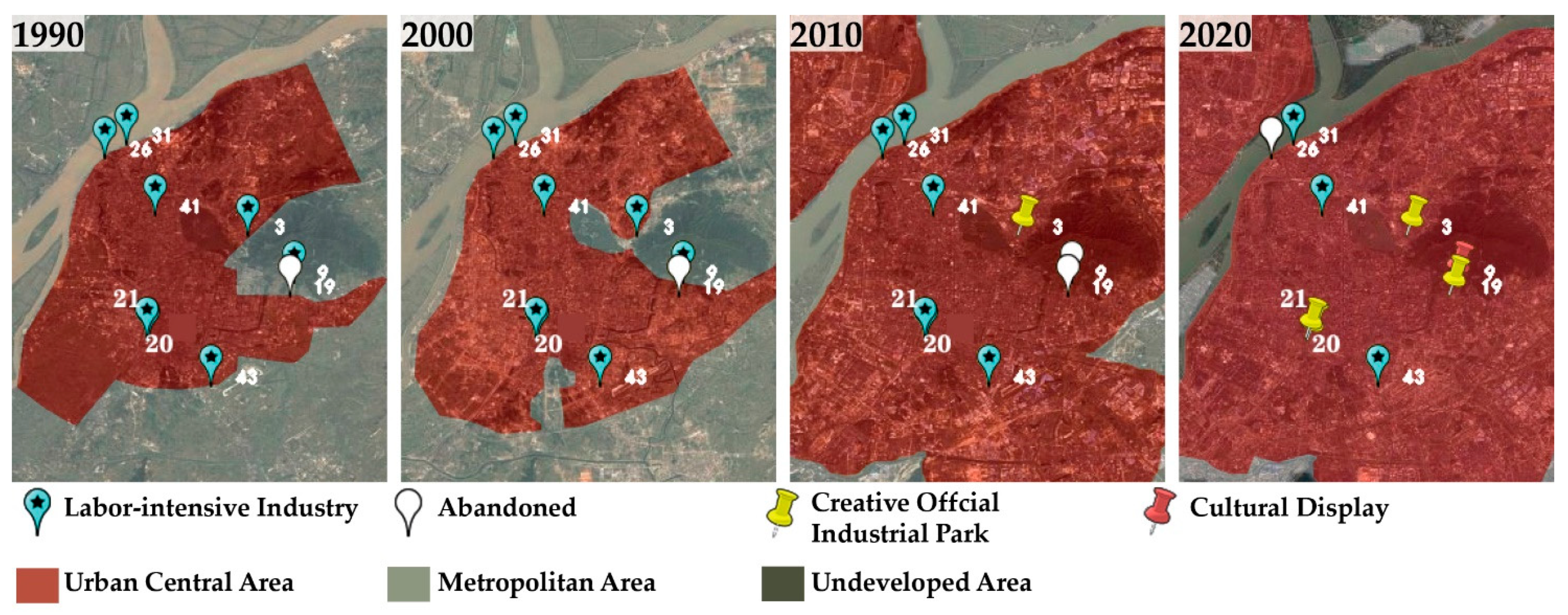

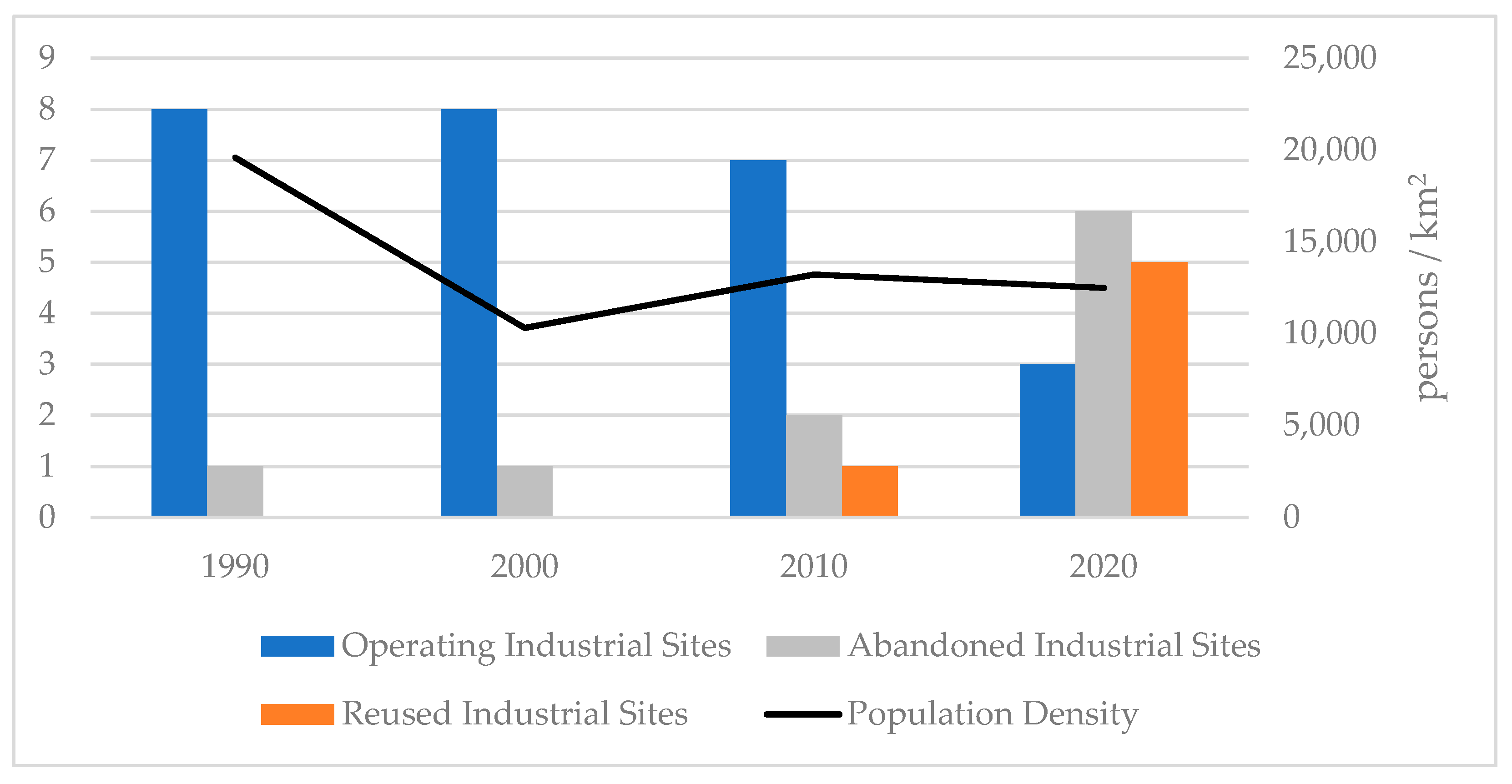
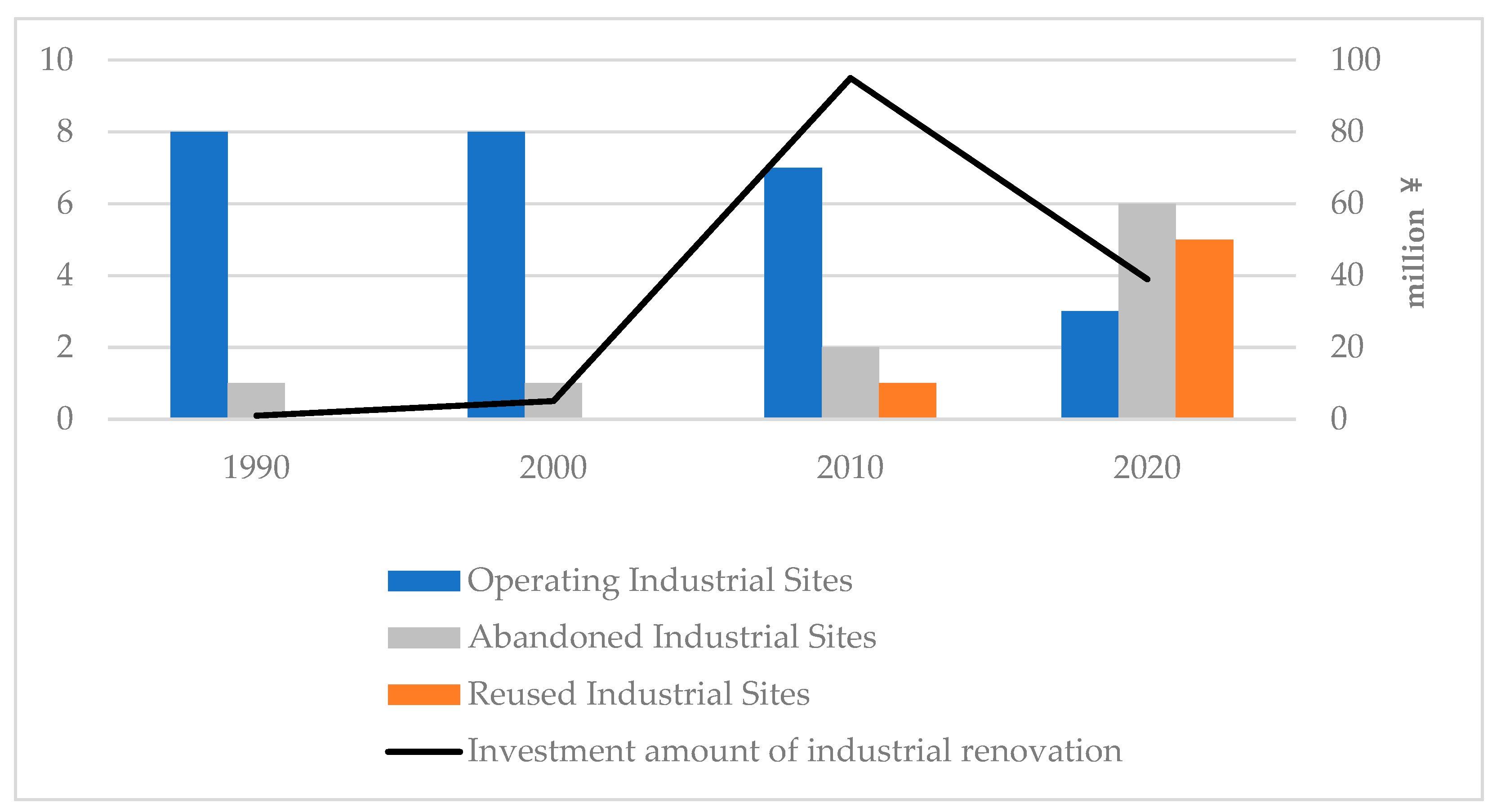







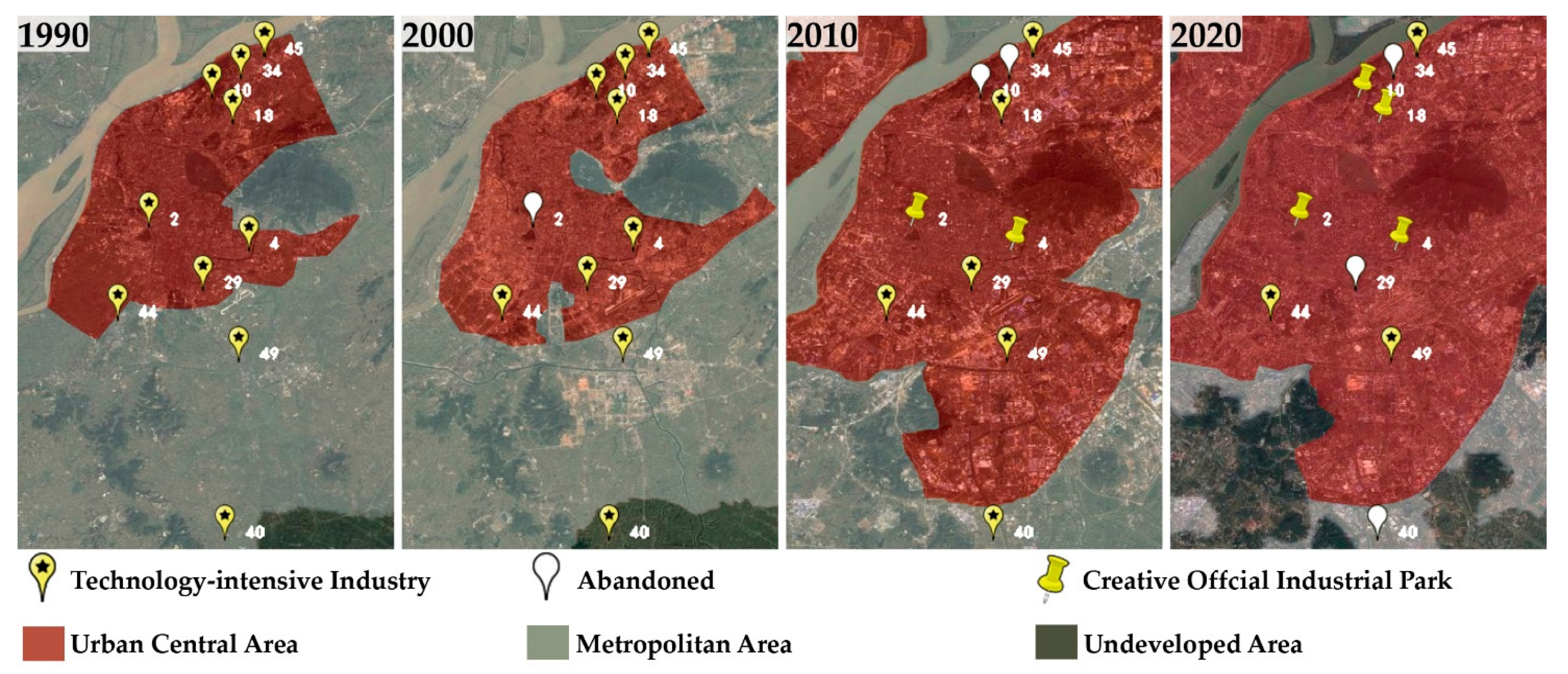
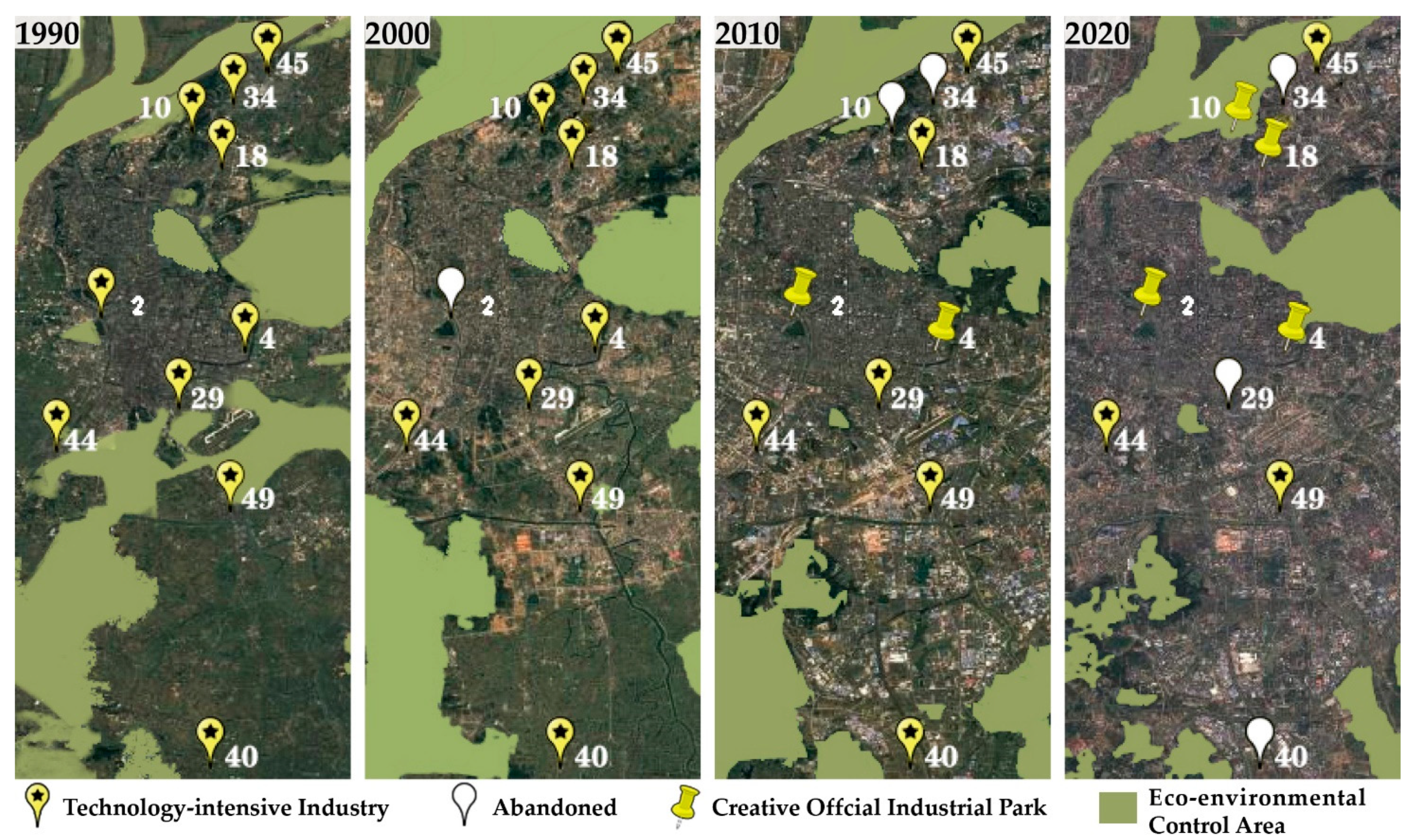


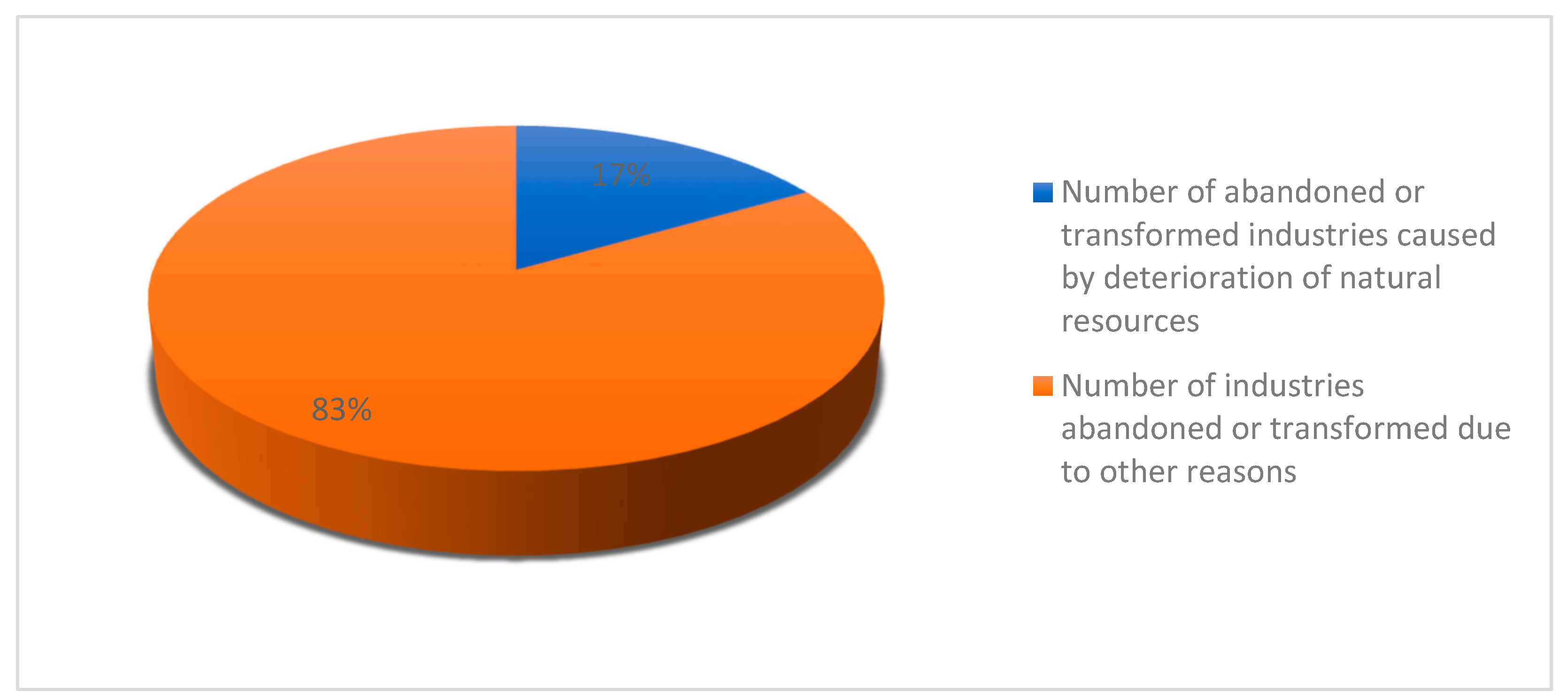


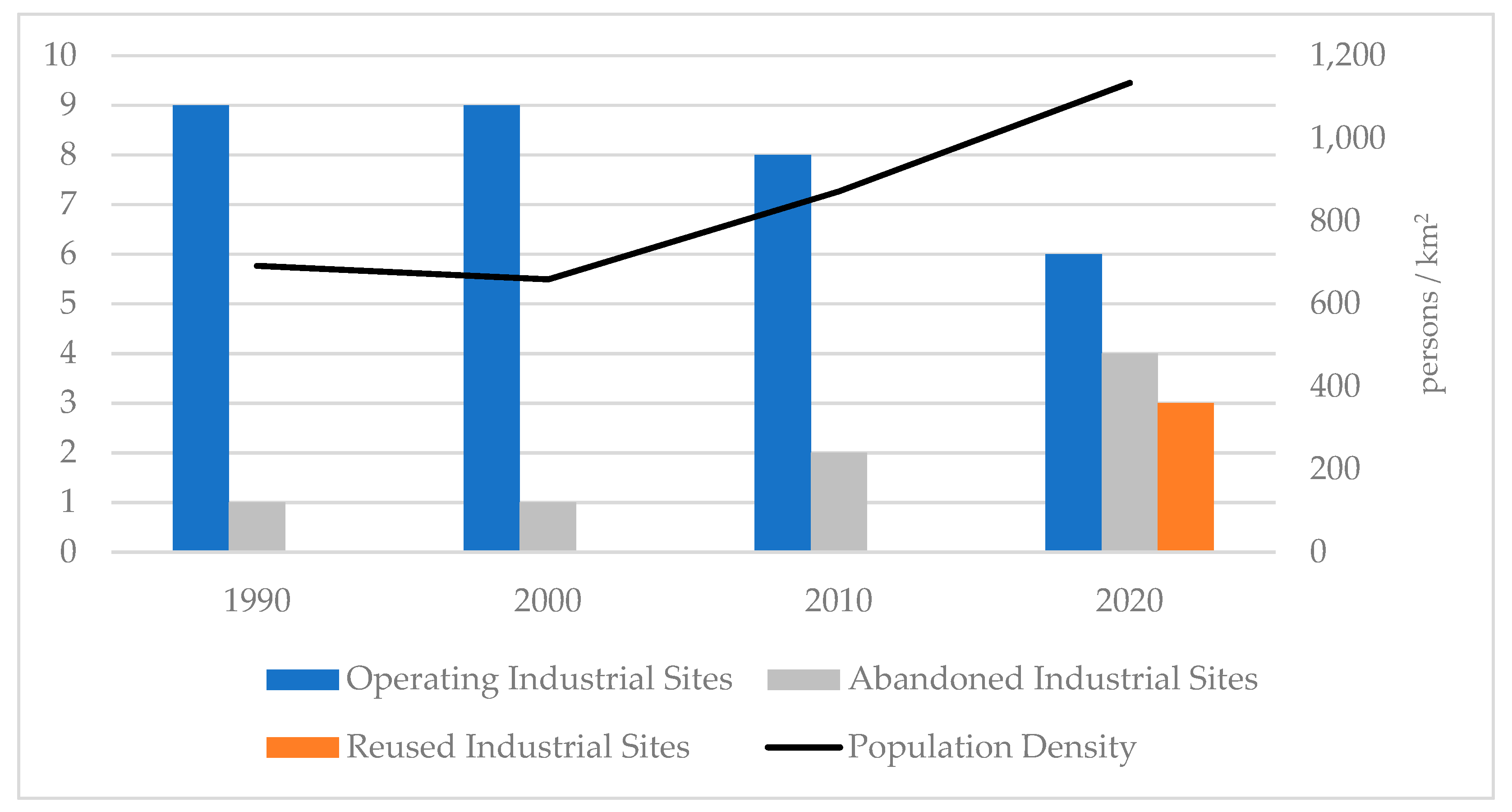
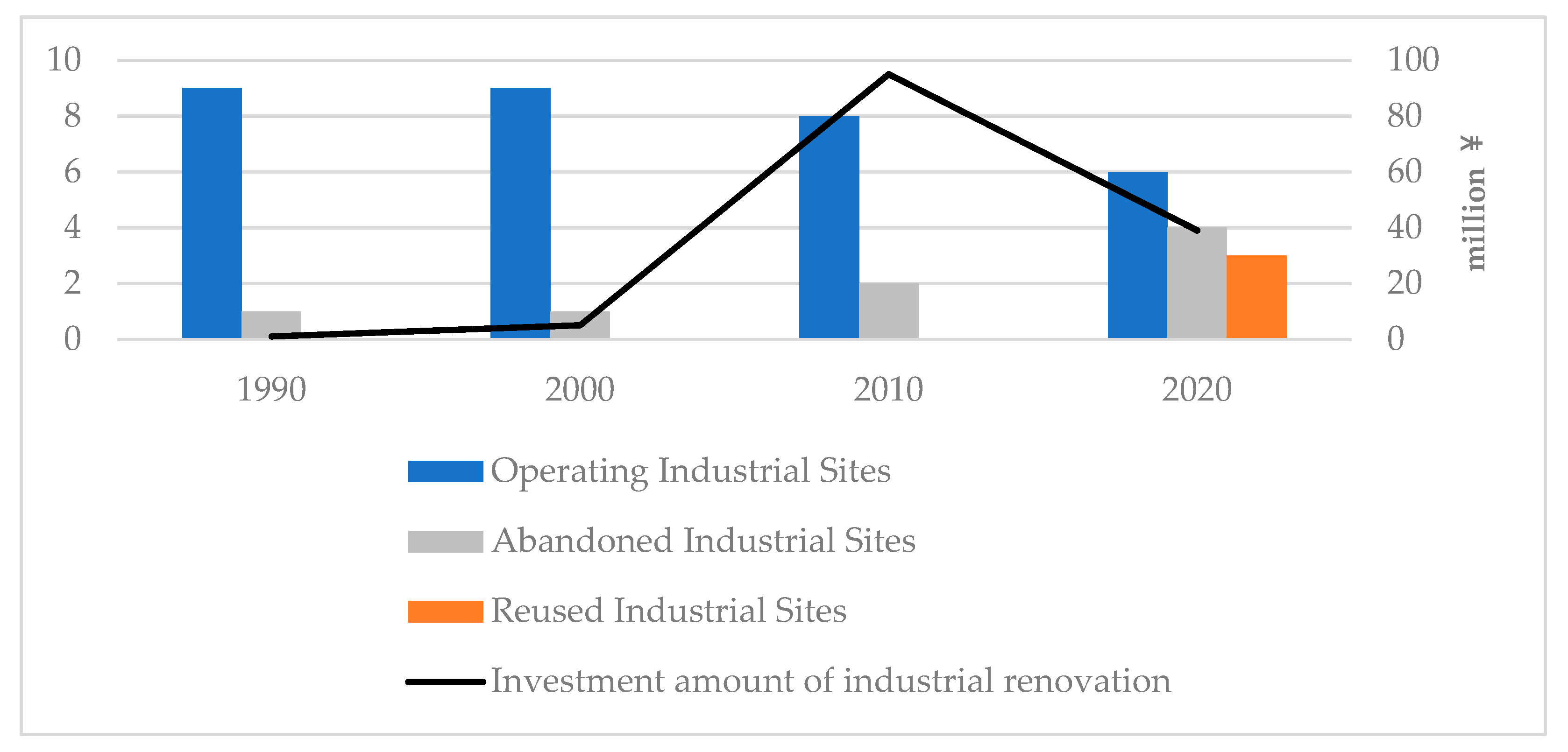
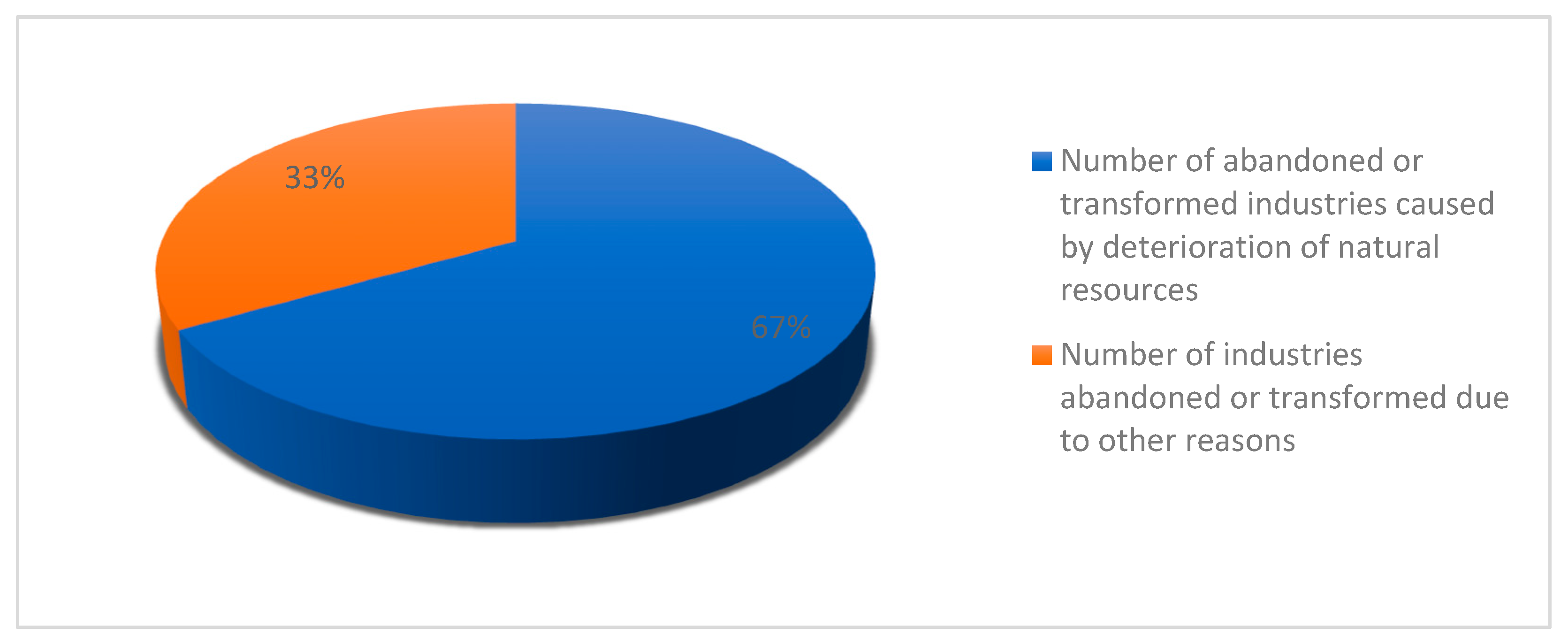
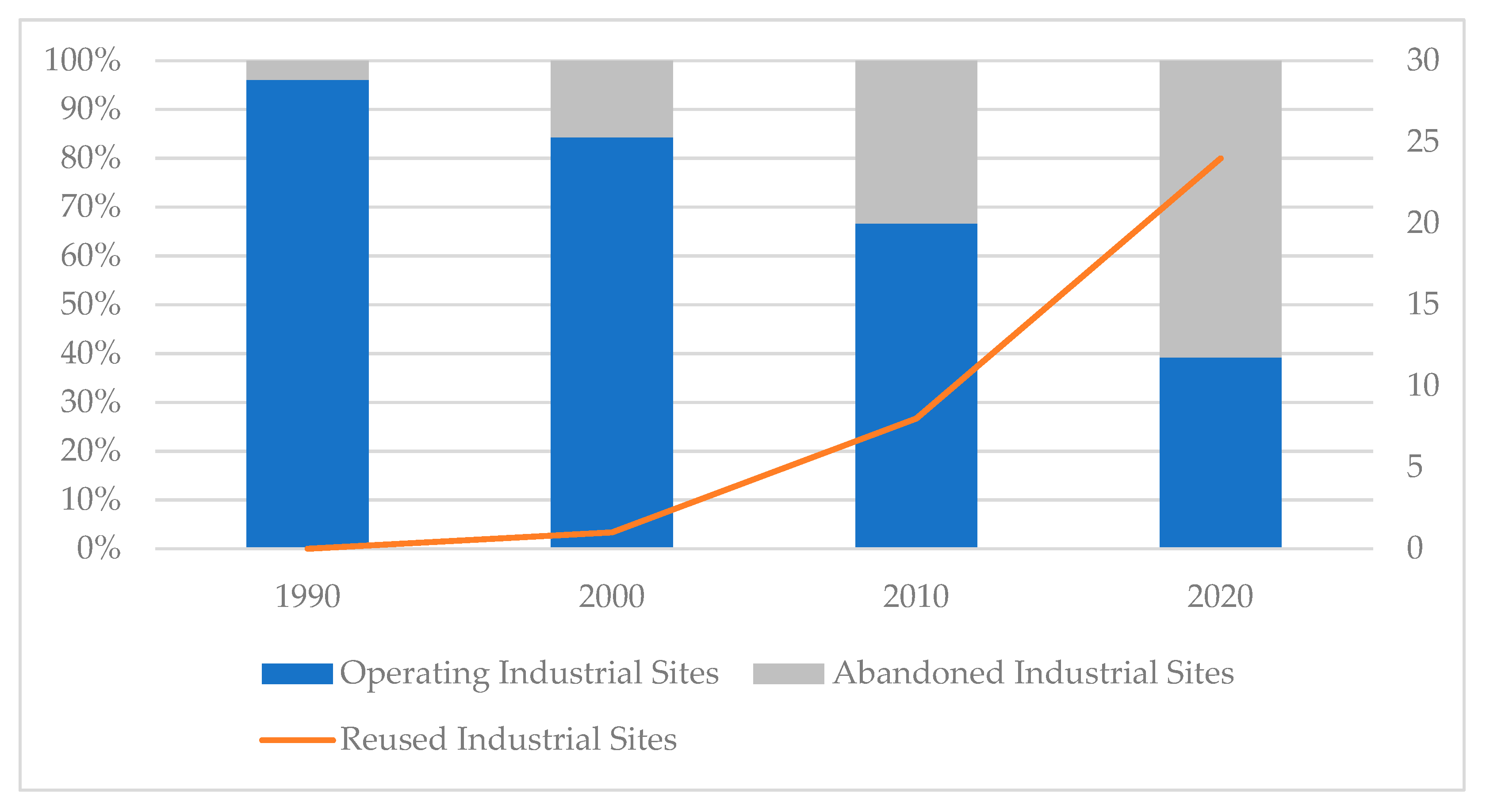
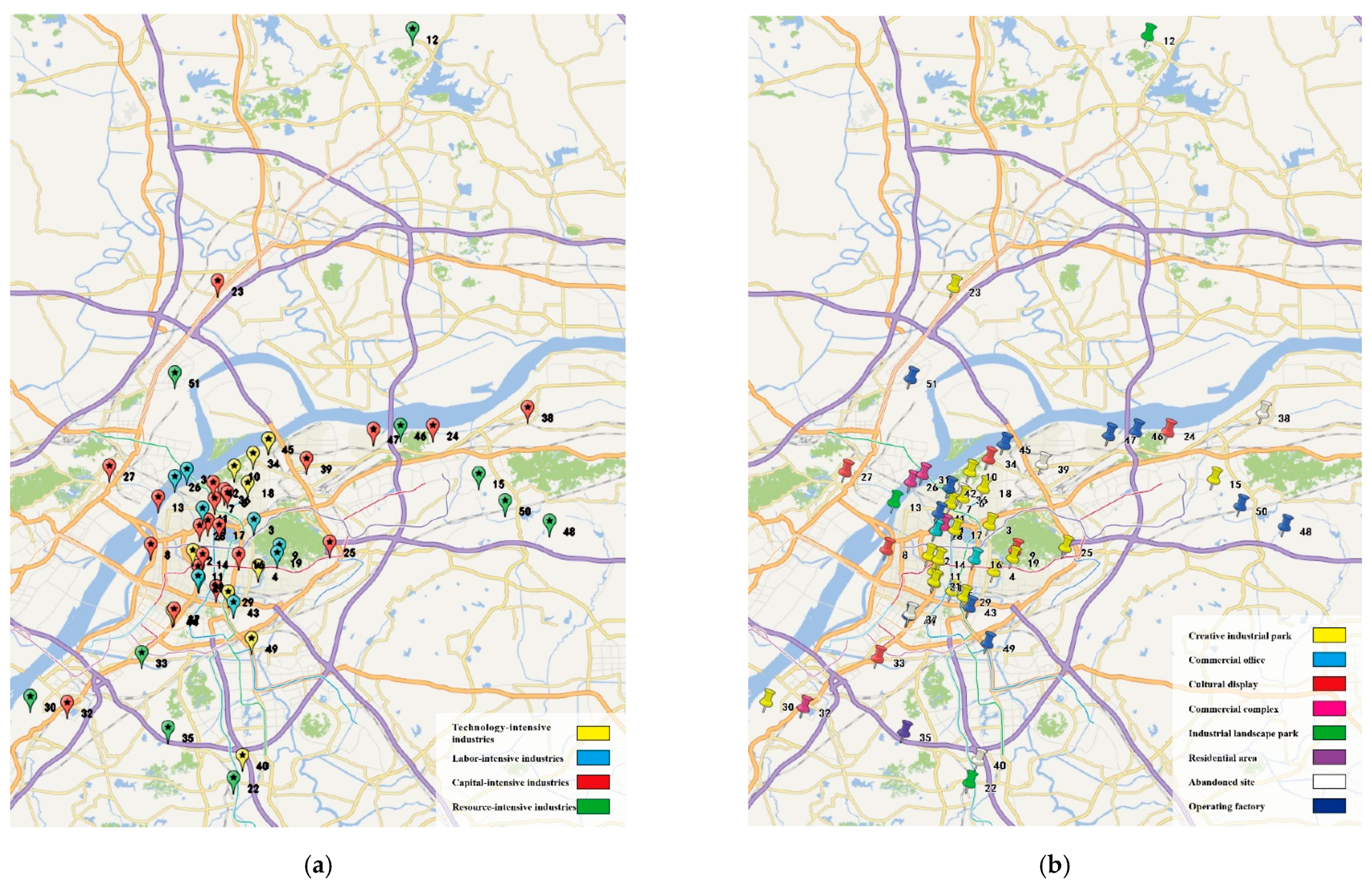
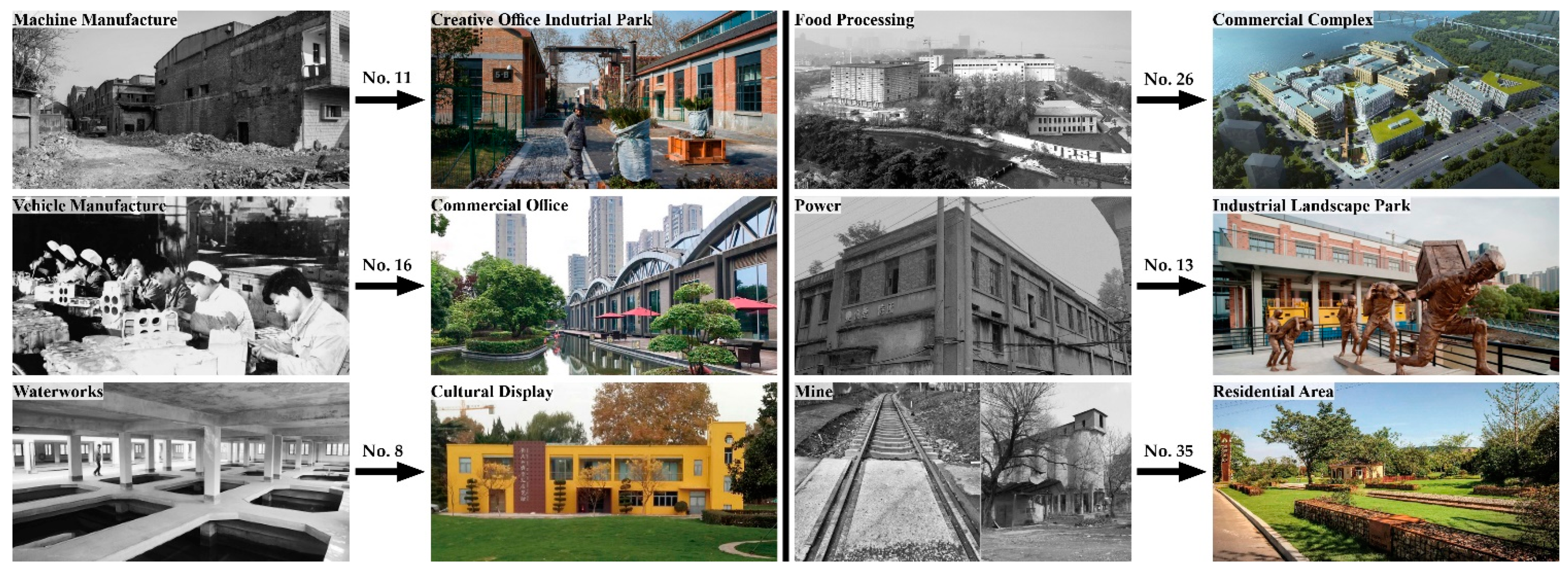

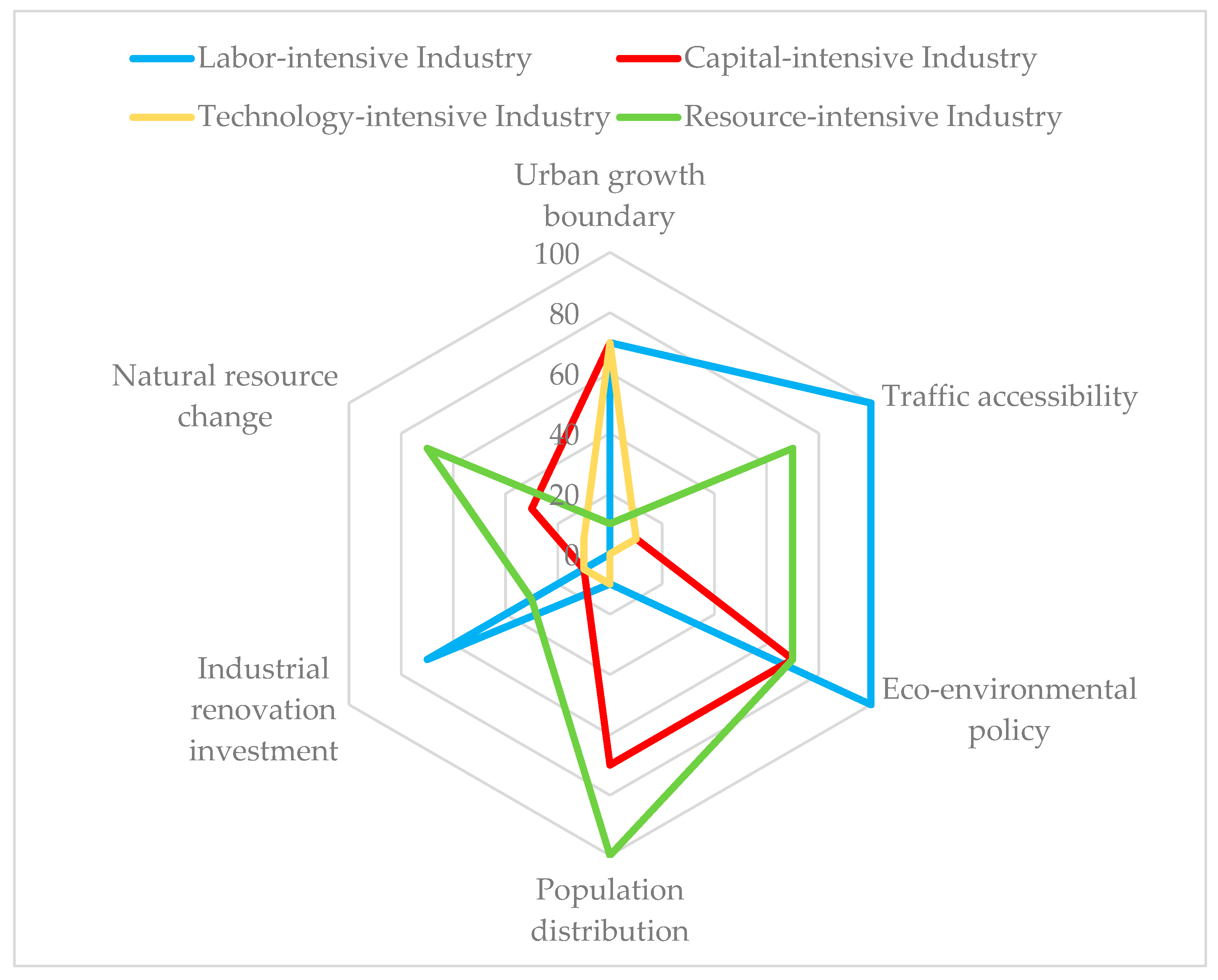
| Site Number | Traffic Accessibility 1 | Is It Abandoned or Reused? |
|---|---|---|
| No. 43 | 1.15 km | No |
| No. 20 | 0.64 km | Yes |
| No. 3 | 0.56 km | Yes |
| No. 21 | 0.56 km | Yes |
| No. 9 | 0.38 km | Yes |
| No. 19 | 0.17 km | Yes |
| No. 41 | 0.08 km | Yes (change from manufacturing to industrial equipment sales) |
| No. 26 | 0 km | Yes |
| No. 31 | 0 km | Yes (plan to relocate in 2023) |
| Site Number | Traffic Accessibility 1 | Is It Abandoned or Reused? |
|---|---|---|
| No. 47 | 0.99 km | No |
| No. 42 | 0.67 km | No |
| No. 27 | 0.28 km | No |
| No. 24 | 0.8 km | Yes |
| No. 37 | 0.66 km | Yes |
| No. 5 | 0.61 km | Yes |
| No. 17 | 0.59 km | Yes |
| No. 16 | 0.33 km | Yes |
| No. 38 | 0.24 km | Yes (forcibly closed by the government in 2021) |
| No. 1 | 0.22 km | Yes |
| No. 25 | 0.22 km | Yes |
| No. 23 | 0.22 km | Yes |
| No. 32 | 0.2 km | Yes |
| No. 8 | 0.12 km | Yes |
| No. 7 | 0.11 km | Yes |
| No. 36 | 0.1 km | Yes |
| No. 6 | 0.06 km | Yes |
| No. 11 | 0.06 km | Yes |
| No. 39 | 0.06 km | Yes |
| No. 14 | 0.05 km | Yes |
| No. 28 | 0.01 km | Yes |
| No. 13 | 0 km | Yes |
| Site Number | Traffic Accessibility 1 | Is It Abandoned or Reused? |
|---|---|---|
| No. 44 | 0.12 km | No |
| No. 45 | 0.1 km | No |
| No. 49 | 0.06 km | No |
| No. 40 | 1.2 km | Yes |
| No. 4 | 0.88 km | Yes |
| No. 18 | 0.51 km | Yes |
| No. 10 | 0.24 km | Yes |
| No. 2 | 0.18 km | Yes |
| No. 34 | 0.15 km | Yes |
| No. 29 | 0.05 km | Yes |
| Site Number | Traffic Accessibility 1 | Is It Abandoned or Reused? |
|---|---|---|
| No. 48 | 2.31 km | No |
| No. 51 | 2.02 km | No |
| No. 33 | 1.58 km | No |
| No. 46 | 0.72 km | No |
| No. 50 | 0.47 km | No |
| No. 30 | 0.16 km | No |
| No. 15 | 6.58 km | Yes |
| No. 22 | 3.06 km | Yes |
| No. 12 | 1.85 km | Yes |
| No. 35 | 0.08 km | Yes |
Publisher’s Note: MDPI stays neutral with regard to jurisdictional claims in published maps and institutional affiliations. |
© 2022 by the authors. Licensee MDPI, Basel, Switzerland. This article is an open access article distributed under the terms and conditions of the Creative Commons Attribution (CC BY) license (https://creativecommons.org/licenses/by/4.0/).
Share and Cite
Wu, Y.; Pottgiesser, U.; Quist, W.; Zhou, Q. The Guidance and Control of Urban Planning for Reuse of Industrial Heritage: A Study of Nanjing. Land 2022, 11, 852. https://doi.org/10.3390/land11060852
Wu Y, Pottgiesser U, Quist W, Zhou Q. The Guidance and Control of Urban Planning for Reuse of Industrial Heritage: A Study of Nanjing. Land. 2022; 11(6):852. https://doi.org/10.3390/land11060852
Chicago/Turabian StyleWu, Yanming, Uta Pottgiesser, Wido Quist, and Qi Zhou. 2022. "The Guidance and Control of Urban Planning for Reuse of Industrial Heritage: A Study of Nanjing" Land 11, no. 6: 852. https://doi.org/10.3390/land11060852
APA StyleWu, Y., Pottgiesser, U., Quist, W., & Zhou, Q. (2022). The Guidance and Control of Urban Planning for Reuse of Industrial Heritage: A Study of Nanjing. Land, 11(6), 852. https://doi.org/10.3390/land11060852







